Rolleiflex SLX
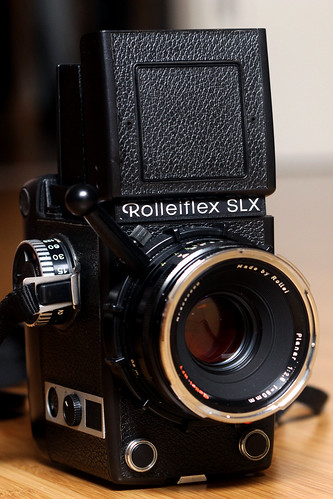
|
| Rolleiflex SLX image by Michael Khan (Image rights) |
The Rolleiflex SLX is an SLR camera for 120 or 220 film, made by Rolleiwerke Franke and Heidecke (Rollei) from 1976. It is intended for 6×6 cm exposures, and can also make 4.5×6 ones with the correct film holder.
The body of the camera is an unusual upright shape, to incorporate a built-in power winder. Unlike Rollei's first SLR, the Rolleiflex SL66, the SLX uses lenses with leaf shutters; there is no focal-plane shutter in the camera. Despite this, the shutter speed control is on the camera body, not on the lens. From its position on the right side of the body, this control could be mistaken for a film advance knob. Shutter speeds from 30 seconds to 1/500 second, plus 'B' are available. The shutter can be set to single or continuous exposures, or locked, with a control below the shutter speed knob.
There are two shutter release buttons, on each bottom corner of the front plate. There is also a socket for an electronic release, next to the single/continuous control. The electronic release allows pre-release of the mirror, to reduce camera shake when the shutter itself is released (this feature is different from the mirror lock on some cameras; once pre-released, the mirror cannot be reset; the shutter must be released). In addition to the standard, short electronic release cable, there are 5- and 10-metre cables. There is also a multiple-exposure control unit which plugs into the same socket, which allows a series of exposures without resetting the mirror or advancing the film. This can also be used as a simple remote release.
The camera has a folding waist-level viewfinder as standard, with a built-in loupe, and with the usual frame-finder feature. There is also a prism finder, usable at 45 or 90 degrees, and a rigid magnifying finder. A number of interchangeable focusing screens were available.
The standard lens is an 80 mm f/2.8 Planar, and there is a reasonable range of interchangeable lenses for the camera:
- 40 mm f/4 Distagon
- 50 mm f/4 Distagon
- 120 mm f/5.6 S-Planar (for macro)
- 150 mm f/4 Sonnar
- 250 mm f/5.6 Sonnar
- 350 mm f/5.6 Tele-Tessar
These are Zeiss lenses, made under licence by Rollei, and all with Rollei's HFT coating. They have helical focusing, again unlike the bellows-focusing SL66. The lens mount is a straightforward bayonet.
The camera has through-the-lens center-weighted metering, and can be used in shutter priority AE or with manual exposure. The film speed is set (between ISO 25 and 6400) on a dial in the face of the shutter-speed knob. For AE, the lens must first be set to 'A'. The meter switch is on the right side, in front of the single/continuous control (this switch also used as the depth-of-field preview control with the lens set to a manual aperture value). When the switch is pressed, the AE-selected aperture is indicated by a needle in the aperture scale of the lens. There are also warning LED lamps at the right hand side of the viewfinder; at the bottom for underexposure (i.e. too fast a shutter speed), at the top for overexposure. Both of these light if the shutter speed is set beyond the AE range; the meter operates between EV 3 and 18 at ISO 100; in addition, shutter speeds longer than 1 second cannot be used with AE. The index of the shutter speed scale, white for most speed values, also becomes red if the speed is set outside the AE range.
Film is loaded into a holder, inserted into the hinged back. The film is loaded into the insert in a straightforward, intuitive way (that is, the film is not passed 'inside out' around the insert, as in, for example, the Mamiya SLRs). The paper leader is wound by hand to the 'Start' marker, the insert put in the camera and the back closed. The film is automatically advanced to frame 1 when the shutter release is pressed. The same insert is used for 120 and 220 film, and there is a switch on the camera back to set which type is loaded. The frame counter is next to this; it is rather small. There are film holders for the 4.5×6 cm format, and a Polaroid back.
There is a hot shoe on the left side of the body.
The camera is powered by a rechargeable 9.6 V nickel-cadmium battery, and cannot be used at all without a battery. There is a warning LED lamp for low battery voltage at the top centre of the viewfinder. The user's manual states that the battery power should still be sufficient to finish the current roll of film when this lights.
SLX 2
A revision of the camera was offered in 1978. Thought sharing the same body model name, it is often called names such as SLX model 2, SLX 2, SLX II, SLX/2. It is nearly identical in design, but it reported to have improved electronics. The second version can easily be identified as it has a cable release socket between the two shutter releases. Other changes include less bright work as the chrome pieces on the right side plate and shutter release trim rings are now black. The 120/220 film format selector works similar but has a different design.
Gallery
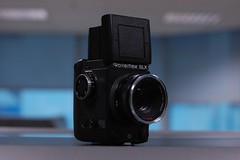
|
| Rolleiflex SLX 2 image by peta-W (Image rights) |
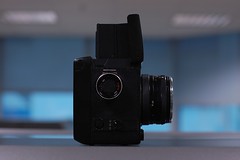
|
| right image by peta-W (Image rights) |
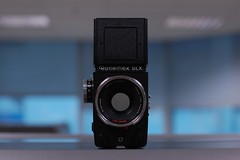
|
| front image by peta-W (Image rights) |
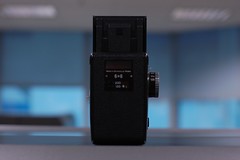
|
| back image by peta-W (Image rights) |
Links
- SLX 2 User's manual (PDF in two parts) at Mike Butkus' Orphan Cameras.